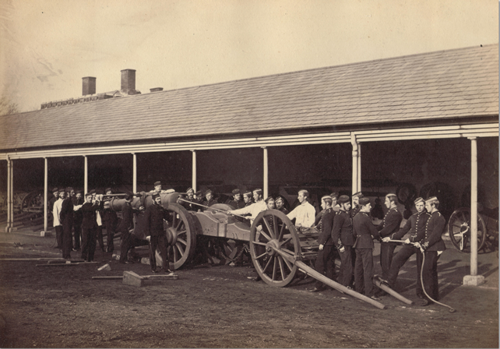| A 24 pounder gun being placed on a siege carriage at Woolwich in 1865. This style of carriage, known as a Block Trail Carriage, was introduced for the 32 pounder 31 March 1860 replacing the box trail design. Its advantage was an improved centre of gravity allowing traverse of the gun by one man. (Woolwich photo courtesy of the Peter Webster Collection) |
It is not clear as to when or why but at some time the two barrels were buried. Some
reports indicate it may have been as early as 1921 but more then likely at a later date. Mr Ron Sullivan recalled playing on the guns until he left the area in 1912 but when he returned in 1921 he recalled the guns were gone. Another old resident of Richmond, Mr George Dell recalled playing on the guns between 1919 and 1923. It is believed the guns were buried when the carriages on which they sat became unsafe and therefore a danger to the children.
Other stories circulated that the guns had been buried around the time of the Japanese attack on Singapore in 1942 due to concerns the Japanese might attack and use the guns on the town. This was typical of the hysteria of the time.
Regardless of why they were buried, their existence remained mainly lost to the memories of the older citizens until Mr Alex Hendrikson, of the Windsor Businessmen's Association, first heard about the cannons at a Parramatta auction in 1975. Along with other members of the organisation he began the search for the guns but without success. The exact location of where they were buried was uncertain with some reports saying they had been buried beneath the foundations of the grand stand.
The RAAF assisted in the search but again to no avail. Reports of the search appeared in the local paper and as a result further information became available. Using the latest information supplied by Mr. Henry Gascoigne, Mr. Eric Ridgeway of Wilberforce, an amateur gold prospector offered his services to the search leaders Cr. Rex Stubbs and Mr Alex Hendrikson.
Within five minutes of commencing the search in February 1985 the presence of the barrels was confirmed by metal detector a metre inside the oval boundary fence fronting the grandstand. Hawkesbury Shire Council arranged for excavation of the cannon. After excavation the cannons were taken to the RAAF Base, Richmond, where they were expertly restored by the No. 2 Aircraft Depot Armament Section and returned to Richmond Park in December 1988.
The first 32 pounder cast iron guns are recorded in the 1720s and the last and over the life of the gun four different designs were produced (Blomefield, Millar, Monk and Dundas). Each came in various lengths and weight. The first 32 pounder guns appear to have arrived sometime around 1858. In December 1870 a total of 45 of these guns were in NSW; two of 50 cwt, 33 of 56 cwt and 9 of 58 cwt). In 1869 it had been 43 and they are noted as being mounted at Dawes Battery (15), Fort Denison (12), Fort Macquarie (7), Mrs Macquarie Battery (8) and one in Colonial Stores. It can be assumed the two guns of 50 cwt had arrived in 1870. The32 pounders appear to have been dismounted by 1874.
Only 10 of these guns are listed in the 1901 Report; two of 50 cwt at Wollongong and eight of 56 cwt. 32 pounder smooth bore guns were converted to 64 pounder rifled muzzle loading guns (RML) in the 1870s and whether this is the fate of the remaining guns is still to be determined. |


